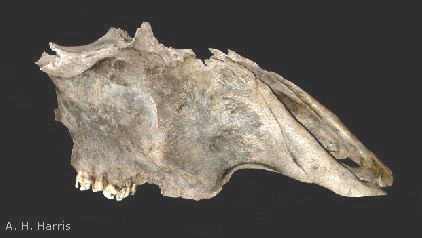

Like most scientists, vertebrate paleontologists seldom feel that they know enough. For many scientists, though, it's a matter of having sufficient time and resources to run an experiment X number of times more. With fossil people, it's often "This is what you have, and this is all that you're going to have—live with it!"
For example, take a specimen from El Paso, reputedly found about 20
feet below the surface during excavations for the construction of Bowie High School. It
consists of the front part of a skull of a bovid—the family of animals that
includes cattle, sheep, and muskoxen, among others. Now for most groups of mammals,
this part would be plenty adequate for identification to species. Among bovids, though,
the missing horn cores—the bony projections from the skull that extend into the
horns—are necessary. Skull proportions do show, though, that cattle and bison are
not represented in this case. Where are we then? We can guess it's between Shrub Ox
or Woodland Muskox, both extinct—but we'll never know for sure.

Contributor: Arthur H. Harris, Laboratory for Environmental Biology, Centennial Museum, University of Texas at El Paso.
Desert Diary is a joint production of the Centennial Museum and KTEP National Public Radio at the University of Texas at El Paso.

The specimen (UTEP Paleobiology 144.1). Front end to the right; the lower border of the eye socket is at upper left. Two greatly worn molars are visible at lower left. Photograph by A.H. Harris.